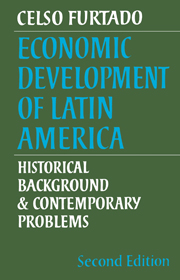Book contents
- Frontmatter
- Contents
- Tables
- Preface to the second edition
- Preface to the first edition
- Abbreviations
- Maps
- PART ONE FROM THE CONQUEST TO THE FORMATION OF NATION-STATES
- PART TWO ENTRY INTO THE SYSTEM OF INTERNATIONAL DIVISION OF LABOUR
- PART THREE THE TRADITIONAL STRUCTURAL PATTERN
- PART FOUR CHARACTERISTICS OF THE INDUSTRIALISATION PROCESS
- PART FIVE REORIENTATION OF DEVELOPMENT IN THE RECENT PERIOD
- PART SIX INTERNATIONAL RELATIONS
- 17 Traditional forms of external dependence
- 18 New forms of external dependence
- 19 Towards the restructuring of the international economy
- PART SEVEN INTRA-REGIONAL RELATIONS
- PART EIGHT STRUCTURAL RECONSTRUCTION POLICIES
- Bibliography
- Index
19 - Towards the restructuring of the international economy
Published online by Cambridge University Press: 25 January 2010
- Frontmatter
- Contents
- Tables
- Preface to the second edition
- Preface to the first edition
- Abbreviations
- Maps
- PART ONE FROM THE CONQUEST TO THE FORMATION OF NATION-STATES
- PART TWO ENTRY INTO THE SYSTEM OF INTERNATIONAL DIVISION OF LABOUR
- PART THREE THE TRADITIONAL STRUCTURAL PATTERN
- PART FOUR CHARACTERISTICS OF THE INDUSTRIALISATION PROCESS
- PART FIVE REORIENTATION OF DEVELOPMENT IN THE RECENT PERIOD
- PART SIX INTERNATIONAL RELATIONS
- 17 Traditional forms of external dependence
- 18 New forms of external dependence
- 19 Towards the restructuring of the international economy
- PART SEVEN INTRA-REGIONAL RELATIONS
- PART EIGHT STRUCTURAL RECONSTRUCTION POLICIES
- Bibliography
- Index
Summary
Traditional exports
In studying the long-term trends of the Latin American economies, the single most striking feature is the immutability of the region's export pattera Apart from a few special cases, we find that despite the considerable changes that have taken place in the production structures of a number of countries, the region's capacity to import is still dependent on exports of a few primary products, which were already being exported before 1929. However, we have seen that the importance of primary products in the pattern of the world economy, and more particularly in the pattern of international trade, has been declining and will tend to decline still further. It is hardly surprising, therefore, that the region's share in world trade should be diminishing, as can be seen from Table 19.1.
The figures in Table 19.1 show that in the period 1948 to 1970, the value of Latin America's exports grew at a rate which was less than half that of the increase in the total value of world trade. The region's participation in world trade, which was 11 per cent in 1948, fell to 7 per cent in 1960 and 5 per cent in 1970, and in the latter year its share of the total was smaller than before the Second World War. In the group of underdeveloped countries, Latin America has also lost ground: the growth rate of the exports of underdeveloped countries taken as a whole was 5.3 per cent in the post-war period.
- Type
- Chapter
- Information
- Economic Development of Latin AmericaHistorical Background and Contemporary Problems, pp. 209 - 224Publisher: Cambridge University PressPrint publication year: 1977



